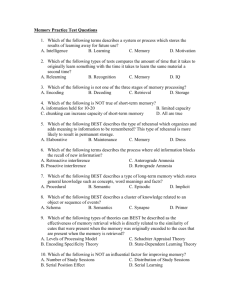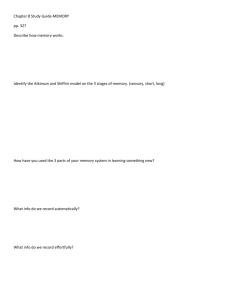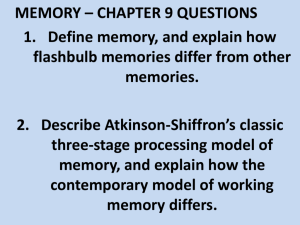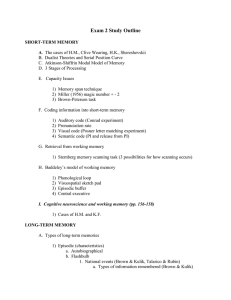Ch.7 PP-Memory
advertisement
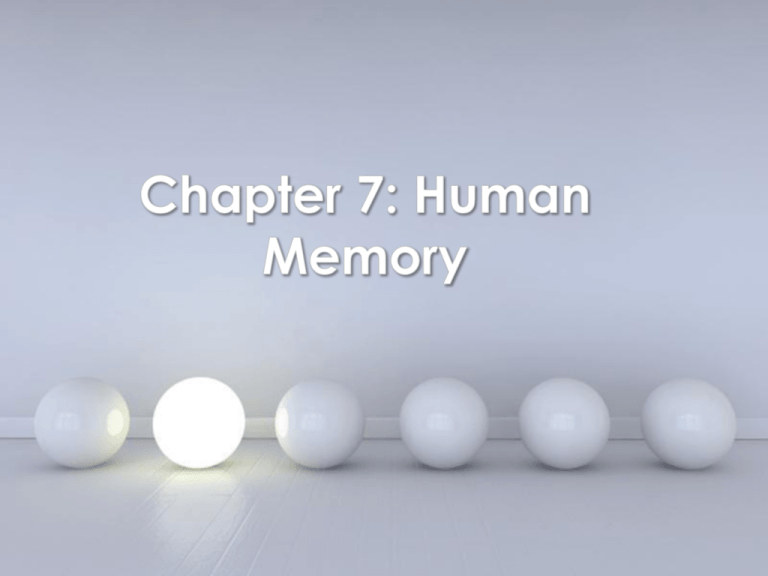
Page 1 Page 2 Page 3 • Attention: Focusing awareness • Selective Attention: selection of input – Filtering: screens out most potential stimuli while allowing selected info to pass through into conscious awareness – Cocktail Party Phenomenon: suggests that filters occur later – Stroop Effect: automatic processes can interfere w/ other tasks Green/Red – Next in Line Effect: when taking turns speaking you forget what is said right before your turn. – Serial Position Effect- When you remember info at the beginning & end but nothing in between Page 4 Page 5 • Incoming info processed at different levels Deeper processing = longer lasting memory codes • Encoding levels: 1) Structural = shallow (physical structure) 2) Phonemic = intermediate (sounds like) 3) Semantic = deep (meaning) Page 6 Page 7 Page 8 • Elaboration = linking a stimulus to other info at the time of encoding – Thinking of examples • Visual Imagery = creation of visual images to represent words to be remembered • Dual-coding theory = semantic + visual codes (2 >1) – Easier to visualize concrete objects • Self-Referent Encoding = making info personally meaningful Page 9 • Information-processing theories – Subdivide memory into 3 different stores • Sensory, Short-term, Long-term – Atkinson & Shiffrin Model of Memory Storage = incoming info passes through 2 temporary storage buffers 1) Sensory 2) Short Term then 3) Long Term Page 10 Page 11 • Brief preservation of information in original sensory form approximately ¼ second • George Sperling (1960): Classic experiment on visual sensory store – Echoic Memory: Auditory – Iconic Memory: Visual Page 12 Page 13 • Limited capacity – magical number 7 +/- 2 (George Miller) – Chunking – grouping familiar stimuli for storage as a single unit • Limited duration – about 20 seconds without rehearsal – Rehearsal – the process of repetitively verbalizing or thinking about the information Page 14 Page 15 • Working Memory – (Baddeley) allows temporary storage & manipulation of the info necessary for complex cognitive tasks (language comprehension, learning, reasoning) It require the simultaneous storage& processing of info. – Executive control system: attentional-controlling system – Phonological rehearsal loop: stores & rehearses speech-based info & is necessary for the acquisition of both native & second-language vocabulary. – Visuospatial sketchpad: manipulates visual images – Episodic Buffer: integrates info before LTM Page 16 Page 17 • Long Term Memory: unlimited store holds memory over long periods of time, relatively permanent • Flashbulb memories: vivid detailed memory of moments or events – Recall through hypnosis Page 18 • Clustering: remember similar items in group • Conceptual Hierarchy: multilevel classification system based on commonalities to remember • Schemas: organized cluster of knowledge based on previous experiences • Semantic Networks: nodes (concepts) linked to related concepts • Connectionist Networks and PDP Models Page 19 Clustering Semantic Networks Conceptual Hierarchy Connectionist/PDP Page 20 Schemas Page 21 Schemas Page 22 • Tip-of-the-tongue phenomenon: a failure in retrieval of something you know • Recalling an event – Retrieval cues: Hints – Context cues: remember when in the location • Reconstructing memories – Misinformation effect: Elizabeth Loftus Page 23 • Reconstructing memories – Source monitoring: make attributions about where memories come from (Marcia Johnson) – Source monitoring error: mistake in the source – Reality Monitoring: deciding whether memories are based on external (actual events) or internal (thoughts or imagination) Page 24 • Retention – the proportion of material retained – Recall: remember without cues – Recognition: remember with cues – Relearning: memorize again to measure how much time/practice before learning occurs • Ebbinghaus’s Forgetting Curve: retention reduces after learning something compared to retention after learning something meaningful Page 25 Page 26 Page 27 • Ineffective Encoding: – Pseudo forgetting you can’t forget something you never learned • Decay theory: memories fade with time (storage) • Primacy effect: higher likelihood of remembering earlier info. (due to rehearsal) • Recency effect: higher likelihood of remembering last info. (b/c STM) • Interference theory: forget b/c of competition from other materials – Proactive: can’t remember new info b/c of old info – Retroactive: can’t remember old info b/c of new info Page 28 Page 29 • Encoding Specificity: memories are linked to the context where they are created (learning a word by the way it sounds then sound would be the retrieval cue to help remember) • Transfer-Appropriate Processing: memory will be best when the processes engaged in during encoding match those engaged in during retrieval • Repression: motivated forgetting Page 30 Page 31 • Biochemistry – Alteration in synaptic transmission • Hormones modulating neurotransmitter systems • Protein synthesis • Neural circuitry – Localized neural circuits • Reusable pathways in the brain • Long-term potentiation: when forming memories synapses strengthen pathways the more you remember Page 32 • Anatomy – Anterograde: cannot remember anything since the accident – Retrograde Amnesia: cannot remember anything before the accident – Parallel Distributed Processing (PDP): hippocampus bind individual elements of specific memories. • Cerebral cortex, Prefrontal cortex, Hippocampus, • Dentate gyrus, Amygdala, Cerebellum Page 33 Page 34 Page 35 • Implicit vs. Explicit – Implicit: unintentional -Explicit: intentional • Declarative vs. Procedural – Declarative: Facts -Procedural: Actions • Semantic vs. Episodic – Semantic: general info –Episodic: Dated info • Prospective vs. Retrospective – Prospective: future actions – Retrospective: previously learned info Page 36 Page 37 • Engage in adequate rehearsal • Distribute practice and minimize interference • Emphasize deep processing and transfer-appropriate processing • Organize information • Use verbal mnemonics • Use visual mnemonics Page 38



